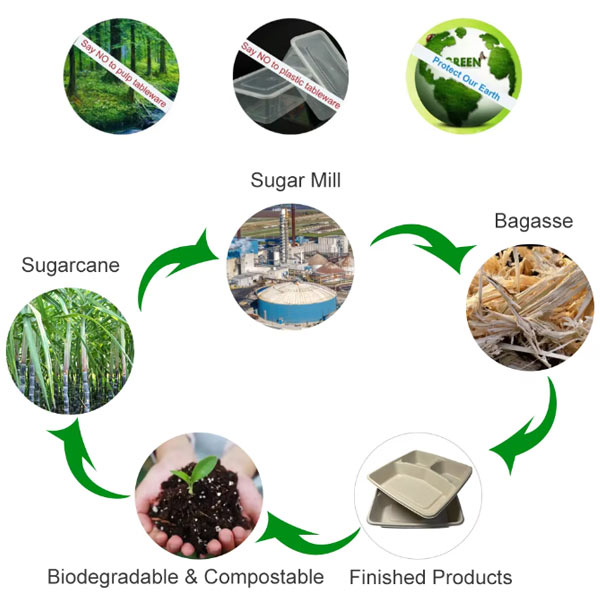Views: 7 Author: Site Editor Publish Time: 2024-11-01 Origin: Site











1. Degradability of Bagasse Packaging Materials
One notable environmental advantage of bagasse packaging materials is their degradability. These materials can be broken down by microorganisms in the natural environment, ultimately converting into water, carbon dioxide, and other harmless substances, thereby reducing environmental pollution. Here are several key points regarding degradability:
Natural Decomposition: Bagasse packaging materials, free from chemical additives, can be decomposed by microorganisms in the soil under natural conditions, unlike traditional plastics that persist in the environment for a long time.
Decomposition Speed: Compared to petrochemical-based plastics, bagasse materials decompose at a faster rate, sometimes completely decomposing within a few months.
Decomposition Byproducts: The substances produced during decomposition are harmless to the soil and ecosystem, and can even act as organic matter to enrich the soil.


2. Environmental Impact Assessment (Life Cycle Assessment)
Life Cycle Assessment (LCA) is a method to evaluate the environmental impact of a product throughout its entire life cycle, from raw material extraction, production, use, to disposal. Here’s how bagasse packaging materials fare in an LCA:
Raw Material Extraction: Bagasse is a byproduct of the sugar industry, and its collection process generates minimal additional environmental impact.
Production Energy Consumption: The production of bagasse packaging materials typically consumes less energy and can utilize renewable energy sources, such as biomass.
Use Phase: During use, bagasse packaging materials do not release harmful substances and are harmless to the environment and human health.
Disposal: Due to their degradability, bagasse packaging materials do not cause long-term environmental pollution after disposal.
3. Comparison with Traditional Packaging Materials
Compared to traditional packaging materials, bagasse packaging materials exhibit several environmental advantages:
Source of Resources: Traditional plastics come from non-renewable fossil fuels, whereas bagasse comes from renewable agricultural resources.
Pollution Reduction: Traditional plastics, which are difficult to degrade, can cause soil and water pollution, whereas bagasse materials can decompose naturally, reducing environmental pollution.
Health Impact: Additives and plasticizers in traditional plastics may have negative health impacts, whereas bagasse materials are safer.

4. Carbon Emission Reduction and Resource Recycling
Carbon Emission Reduction: The production process of bagasse packaging materials significantly reduces CO2 emissions compared to the production of traditional plastics. This is because sugarcane absorbs CO2 through photosynthesis during growth, and the energy used in production is often biomass energy, further lowering carbon emissions.
Resource Recycling: The utilization of bagasse realizes the resourceization of agricultural waste, transforming what was once discarded sugarcane residue into valuable packaging materials, promoting resource recycling.
Promoting Carbon Cycle: The decomposition process of bagasse packaging materials is part of the carbon cycle, helping to maintain carbon balance in ecosystems.
Home / Products / FAQ / About Us / Compostable Bag / Contact Us